Local farmers see mixed bag in drought
Published 12:00 am Tuesday, July 16, 2002
By MELISSA PEACOCK
“The drought was terrific,” said local pumpkin and melon farmer Timmy Perilloux from atop his spraying tractor. “I can handle the dry weather up until Nov. 1.”
Perilloux has been growing pumpkins and watermelons on about 23 acres on River Road for more than 17 years. During a dry year he can produce as many as 90 pumpkins for every three acres he plants.
Perilloux, who has also grown cabbage, mustard, turnips and okra, said pumpkins are the most difficult crop to grow in the River Parishes area.
“I grow a lot of different things but pumpkins are probably the hardest to grow because of the amount of rain we get,” Perilloux said. “We’ve tried about 19 varieties of pumpkins and none of them did well at all because of the rain.”
The pumpkins grown on Perilloux’s farm are called Creole Pumpkins. They are normally a light peach or dull orange color.
“They prefer dry weather,” Perilloux said. “Right now we’re getting a little rain and it’s not hurting them. It becomes more of a problem when the little melons start to show.”
Perilloux’s pumpkin business started by accident in the 1980s when a local lady in charge of a troop of girls found out about Perilloux’s small vegetable patch and asked if she could bring them out to the farm. The following year, five classes found out and called to schedule a trip to the farm.
Now, Perilloux’s farm is a favorite field trip destination for area schools, especially around Halloween. Because of the growth, Perilloux has expanded his operations to include multiple tractors and wagons.
“One tractor pulls three wagons – two people-pulling wagons and one wagon to put their pumpkins in,” Perilloux said.
Perilloux said he has never had to advertise the farm. Most visitors hear about his pumpkin patch by word-of-mouth. Everyone comes by appointment.
“The plants (this year) are beautiful,” Perilloux said. “This is the best stand (frequency of the plant). But it doesn’t take but a day or two and you can lose it all.”
According to Perilloux, the pumpkin plants were enjoying an incredible amount of success in 1998, but were completely wiped out by Tropical Storm Francis.
“I had a beautiful crop, super beautiful,” Perilloux said. “Then on about Sept. 15, give or take a few, the rain killed them all.”
About three years ago, Perilloux added watermelons to his crops.
“The drought was terrific for them – it makes them bigger and sweeter too,” Perilloux said. “I had some as big as 50 pounds thanks to the drought. Now, since the rain started, I was a bit worried that it would cause them to start rotting, but I think they were already too mature and ready for harvest.”
Perilloux reported less than a 10 percent loss in watermelons this season.
Other small commercial farmers in the area have not been so lucky, reporting devastating losses in crops due to the drought. Virtually none of the local small commercial farmers use irrigation systems.
“It (drought) was hurting everything else – tomato, okra, cucumber,” farmer Harold Bailey said. “Everything is done now. About the only thing it (rain) is going to help is the grass.”
Bailey, who has been selling fresh produce on Airline Highway since about 1965, reported a substantial loss of tomatoes as a result of the dry season.
“Last year we had plenty of rain, too much rain,” Bailey said. “This year is too dry.”
The vegetable growers were definitely hit the hardest by the drought, said Rene Schmit, St. Charles Parish county agent of LSU AgCenter.
“We were hit very hard with 25 percent up to 35 percent loss in vegetable crops,” Schmit said. “We went for 10 weeks with little rain. We’re not effected so much by the drought anymore. Now we’re actually concerned because we’re getting too much rain.”
According to Schmit, the area needs about four inches of rain to compensate for moisture loss.
“We’ve started to hit that now,” Schmit said. “We’re catching up.”
But sugarcane growers will not know whether the rain is “too little, too late” until September.
“The populations (number of sugar cane stalks per plant) are looking good,” Schmit said. “The size of the roundness of the stalk and the height of the cane are looking well.”
But while the height average in the younger cane (first to third stubble) has improved, some delay is being seen in the older cane.
“The cane stays in the ground five years,” Schmit explained. “Each year it stubbles, providing a little less tonnage – a little less cane and sugar for every year of growth.”
Until autumn, we will not know the extend of the drought’s damage on sugar crops – or the effects of the rain on Perilloux’s pumpkins.
Dry weather can be a mixed blessing.





